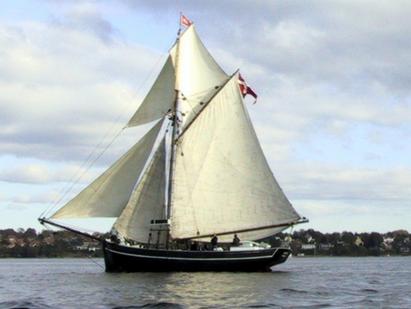Ruth (Sloop)
The Sloop Ruth was constructed in 1854 at Svinör in South Norway. The vessel was built for the route between Northern Jutland in Denmark and South Norway. Over hundreds of years a healthy trade had taken place involving the exchange of cereals and other agricultural products from North Jutland for timber and iron from Norway. Early on this trade used large open boats with masts bearing square sails. After the English Wars (1807-14) this type of ship disappeared completely and was soon replaced with decked boats, known as Danish schooners. Ruth is the last preserved example of this type of vessel.

Originally the majority of the Danish schooners were clinker built in oak to provide the necessary strength and elasticity. This was required to enable the use of the sails in high seas, but also to withstand the inevitable jolts and bumps when the ship travelled between sandbanks on the harsh west coast to transfer its load to large boats, which were rowed out from the beach. As the Denmark route gradually ceased to operate, the ship entered Danish hands in 1888. Afterwards it became part of the ordinary Danish traffic of small ships – with detours to Sweden and North Germany – to all the places where cargo could be obtained. It still had the original rigging. However, in 1898 the ship was given a total renovation. The planking was changed from clinker to carvel construction and the ship underwent extensive repairs. For 45 years it sailed a packet route on the Limfjord under the name of Ruth. It was based at Nykøbing Mors and had the same captain throughout this period. After the death of its owner in 1968 it was bequeathed to another museum, but today is owned by the National Museum. Thanks to a donation from Lodbergs Legat in 1978 it was possible to repair the hull and preserve the unique form of the last Danish schooner. In 1993 Lodbergs Legat and Civilingeniør Aage Louis Hansens Mindefond donated a combined amount that enabled the completion of the restoration. The ship was ready and rigged in 1996, deliberately going back to the form it had after the large-scale renovation of 1898. Its sails were based on the original ones and there was no wheelhouse or engine. The skipper’s cabin, front cabin and hold were now furnished exactly as they were at the time when the ship was solely dependent on wind for its momentum. It still operates using just sail power, and without a motor. Today Ruth is based at the Viking Ship Museum’s harbour at Roskilde. The ship is sailed and maintained by a group of volunteers, who sail it around Danish waters every summer.
